Trees and Plants in the Orchard
Apples
New Rock Pippin Apple
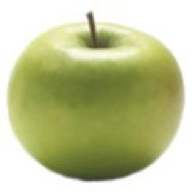
New Rock Pippin (Malus domestica) New Rock Pippin belongs to the Nonpareil family, and is valuable as a late winter apple. It is a dessert apple of first-rate quality which was raised by William Pleasance, a nurseryman in the Barnwell area of Cambridge. It was first reported to the London Horticultural Society in 1821.
The fruit is of medium size, round, even, and sometimes obscurely ribbed. The eye is closed, set in a round and plaited basin. The stamens are marginal, tube, deep, conical. The stalk is short, inserted in a deep, round cavity. The skin is dull green, on the shaded side, and brownish red where exposed to the sun, very much covered with brown russet.
It is usually picked in mid October for use between January and March/May. The flesh is yellow, firm, sweet, rich, and perfumed with the flavour of anise coupled with excellent keeping qualities. It is best for cooking and baking.
Wayside Apple
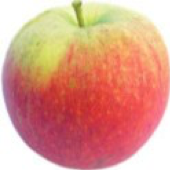
Wayside Apple (Malus domestica Wayside) is a seedling of the variety Charles Ross. It owes its name to an early grower – Miss Cunningham who lived at ‘Wayside’ on the Huntington Road in Cambridge. It was first recorded in 1930.
Charles Ross is a classic English late-Victorian apple. It is a cross between Cox’s Orange Pippin and an older English cooking apple called Peasgood Nonsuch. The result is a versatile apple, which looks like a large Cox’s Orange Pippin, with the characteristic red-orange streaks, but sometimes with a more yellow background.
The fruit is ready for picking in late September and eating in October to November. The flesh is juicy but quite light, becoming almost powdery as it matures. The flavour is very sweet, but not bland – it has some of the aromatic qualities of Cox’s Orange Pippin and is reminiscent of pears.
Charles Ross is also a useful cooking variety. When fresh from the tree, the flesh does not entirely breakdown into a puree. It is ideal if you like apple pies with chunky apple pieces. Being quite large and juicy it is also a good variety for making your own fresh apple juice.
Histon Favourite

Histon Favourite (Malus domestica Histon Favourite) is a small eating/dual purpose apple raised by John Chivers of Histon, near Cambridge, in the mid-nineteenth century. Later in the century it was grown widely throughout the county of Cambridgeshire.
The fruit has a pale yellow skin with a scattering of pink stripes. It is ready for picking in late September and eating in October to December. It has a sharp and crisp flavour when picked, mellowing with storage.
The Chivers family developed a number of apples for their own use, including Chivers Delight, Histon Favourite and the lost variety Histon Cropper. In 1873 John Chivers opened a jam-making factory at Histon that used the produce from his extensive orchards. The factory was self sufficient; it had its own water supply and electrical generation by 1890. Not only did they make their own cans, but also they came to have their own engineers, paint shop, sawmill, blacksmiths, carriage works, coopers, carpenters, building department and even basket makers. In 1959 the factories and farms were sold to Schweppes but the factory no longer exists.
Jolly Miller

Jolly Miller (Malus domestica Jolly Miller) apple dates from 1883 when it was popular in the Cottenham area of Cambridgeshire. It is possibly takes its name from the village pub of the same name where fruit was once traded. It is a medium sized tall apple with a greasy yellow skin, reddish flush and broken red stripes. By the time it is ready for picking and cooking in late September, it resembles a ripe tomato in appearance.
Crab Apple

Crab Apple (Malus sylvestris) is a small, attractive deciduous tree which produces white/pink blossom in the spring followed by crops of apples in the autumn. The flowers are hermaphrodite and are pollinated by insects; they are also good pollinizers in apple orchards. It can take five years or more for the tree to be mature enough to flower and fruit.
Crab apple fruits are very small and normally green, ripening to yellow or red. They are less than 3.5cm in diameter and have a long stalk. It is by the fruit that you can best identify a crab apple – they are almost like cherries in shape and size.
Crab apples are an excellent source of pectin but are very sour to the taste. Their juice can be made into a ruby-coloured preserve with a full, spicy flavour. The flesh is suitable for making jams, jellies and preserves.
Plums and Gages
Wallis's Wonder Plum

Wallis’s Wonder(Prunus domestica Wallis’s Wonder) was first grown about 1960 by Eric Wallis at Heath Farm Bluntisham in the heart of Cambridgeshire. It was custom raised by Simpsons of Fordham by crossing a Severn Cross plum which originated in Somerset with a Victoria plum which originated in Sussex. It is still grown at Heath Farm.
Cambridge Gage
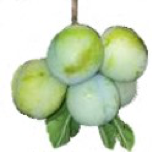
Cambridge Gage (Prunus domestica Cambridge) is a heavy cropping gage that originated in Cambridgeshire in 1927. It is one of the most popular greengages, very similar to the old fashioned greengage but more reliable. It is a good, vigorous grower that does set some fruit without a pollinator. Has received the Award of Merit from the Royal Horticultural Society.
It is grown on St Julien A rootstock for an ultimate (un-pruned) height of 3.65 – 4.6 metres. It is self fertile – but pollination by another apricot will maximise yield. It has extremely good disease resistance and is not prone to leaf curl.
Willingham Gage
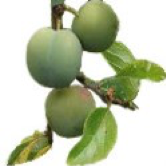
Willingham Gage (Prunus domestica Willingham) arose at Willingham in Cambridgeshire, probably as a seedling of a Green Gage in the 1800s. It is an ease of care, self fertile and excellent cropping variety, much favoured for its superb quality fruits. For these reasons, it has been selected by the Royal Horticultural Society. The fruit is similar in appearance but larger than that of the Green Gage. The fruit ripens around mid August when the flesh is sweet and juicy to taste.
Apricots
Apricot Hargrand
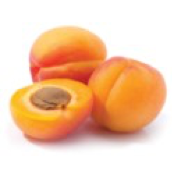
Apricot Hargrand (Prunus armeniaca). Originating from Canada, this fairly new variety is renowned for its extreme hardiness. Produces heavy yields of deep orange-red fruits that are ‘freestone’ (the flesh comes away from the stone easily). The fruit is ready for eating between July and August.
It is grown on St Julien A rootstock for an ultimate (un-pruned) height of 3.65 – 4.6 metres. It is self fertile – but pollination by another apricot will maximise yield. It has extremely good disease resistance and is not prone to leaf curl.
Flavorcot Apricot

Favorcot Apricot (Prunus armeniaca). This is a new American apricot variety specially bred for temperate climates. It is grown on a St Julien A rootstock and should reach 4m after 10 years. It has ovate to rounded, toothed, dark green leaves.
The beautiful pink-tinged flowers appear in early spring. It is self-fertile; the major cause of poor pollination is bad weather at blossom time. The fruits are very large and juicy with a red blush and succulent, sweet orange flesh with superb aromatic flavour. They are ready for eating straight from the tree in August. They preserve well and make wonderful jam.
Pears
Laxtons Foremost
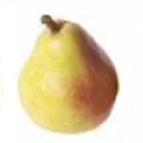
Laxton’s Foremost (Pyrus communis). This is a cultivar pear which was raised at the Laxton Brothers Nursery near Bedford in 1939 by crossing the varieties Marecahl de la Cour and Fertility.
The fruit is large and yellow but can have a reddish flush and a few red stripes. It is harvested in mid to late September. The flesh is buttery and sweet.
Warden Pear
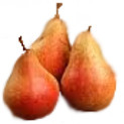
Warden Pear (Pyrus communis Warden). This pear has an ancient heritage and was possibly introduced by the Romans. The tree spread around the country during the Norman period and was first recorded at Warden Abbey, a Cistercian monastery in Bedfordshire, during the 13th century. It is similar to the variety Black Worcesteris which features on the county arms of Worcestershire.
The trees blossom from mid-April onwards. The fruit is large with greenish brown rough skin, usually flushed dark red. They are hard and gritty and ripen slowly for picking in October and culinary use from November to February. The flesh is coarse and firm and excellent for bottling and baking. It was used for making the famous ‘warden pies’. In Shakespeare’s The Winter’s Tale, the clown says: “I must have saffron the colour of Warden pies”.
Cherries
Subhirtella Cherry
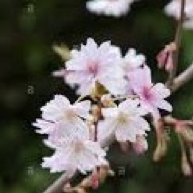
Subhirtella Cherry (Prunus subhirtella). It is capable of reaching a height of 8m at maturity, but usually attains rather less. It bears white to pink flowers which may emerge intermittently from autumn through to spring.
The flowers are pink in bud, semi-double, 1cm across, pendulous, held in small clusters and white when fully opened, although they acquire pink tones as they fade. The flowers have a delicacy and charm completely unknown to the more showy spring-flowering cherries. The leaves are 7cm long, oval and sharply toothed. The autumn leaf colour is better than in many other ornamental cherries.
Stella Cherry
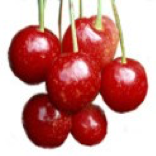
Stella Cherry (Prunus stella). An exceptional self-fertile, sweet cherry with large dark red or black fruit. White flowers appear in mid-spring, followed by delicious, juicy cherries which are ready for picking in late July. An early and prolific cropper that also makes a good pollinator.
Sunburst Cherry
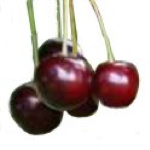
Sunburst Cherry (Prunus sunburst). Sunburst is a self-fertile, highly popular, sweet dessert cherry. The fruit is very large, near black in colour with dazzling flavours. Picking time is July onward.
Miscellaneous
Quince Vranja and Meeches Prolific
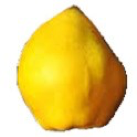
Quince (Cydonia oblonga). are remarkable fruit originating in Persia and Turkestan, and were known to the Greeks and Romans who dedicated them to Venus or Aphrodite as a symbol of love, happiness and fertility. We planted 2 different quince trees in 2010 – Vranja and Meeches Prolific. They are ornamental, medium-sized, flowering trees with pretty blossom and good autumn colour. In May or June the pink/white flowers readily form at the tips of the young Quince shoots.
Quince are grown mainly for their fruit which cannot be eaten raw but make excellent jelly or preserve. They should be left on the tree as long as possible to develop their flavour, provided there is no danger of frost. They usually ripen in late October or early November when they will be golden-coloured and aromatic. They should be stored in a cool, dark place on shallow trays without touching. Allow them to ‘mellow’ before use. They will keep for two or three months.
Light pruning is generally undertaken just after flowering. Heavy structural pruning is done in winter while the plant is dormant. Start at the base and remove all the suckering growth and any downward-facing branches. Remove any crossing limbs from the centre and any whippy growth from the top of the tree. If a branch cannot be cut with secateurs or loppers, it should be left.
Fig Brown Turkey

Fig Brown Turkey (Ficus carica) Sunis an Asian species of flowering plant in the mulberry family. Both the tree and fruit are commonly called ‘the fig’. Native to the Middle East and western Asia, it has been sought out and cultivated since ancient times and is now widely grown throughout the world, both for its fruit and as an ornamental plant. The RHS have awarded it the Award of Garden Merit.
Mulberry King James I
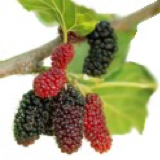
Mulberry King James I (Morus nigra). The black mulberry is native to western Asia but was introduced to Europe in Roman times. There is a fascinating history to the King James variety. It is derived from a tree that existed in the 17th century, in a garden in Swan Walk, which became the Chelsea Physic Garden during the reign of King James I. During the 1939/45 war the last remaining tree was about to be grubbed to make way for an air raid shelter when cuttings were taken and from these the trees of this name have survived.
The fruit matures slowly during the summer months ripening over a long period during August. When fully ripe it is very dark red, almost black in colour. It is very juicy and has a very distinct, delicious, sweet sharp flavour. It can be eaten fresh or used in jams.
Our 2 mulberry trees were planted in 2011 and 2016; the older one overlooking the main Common. The mulberry tree has a spreading habit and becomes crooked and gnarled with time, making it an architectural feature. Prune mulberries when they are fully dormant – about a month after leaf fall. This should prevent sap bleeding from the cut surfaces. Each winter, remove badly placed shoots that interfere with the shape of the tree. Remove any that appear on the trunk below the framework and those that are dead, broken, crossing or over-crowded.
Medlar Nottingham
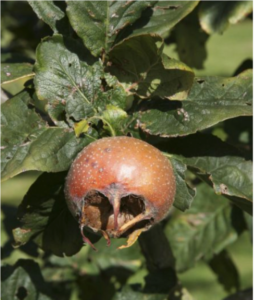
Medlar Nottingham (Mespilus germanica). The name Medlar originates from France. It is a hugely underrated variety of fruit that has a sublime apple-pear sauce flavour and texture. Not the prettiest of fruits, it was commonly known as the “Dog’s Arse Fruit” or “Open Arse Fruit”. Horror stories say that it should be allowed to rot before eating!
Taken fresh from the tree in early Autumn, the fruits are hard and sour to taste – and so they need to be bletted before they can be eaten raw or used for making sauces, jellies and marmalade. Bletting is simply allowing the fruit to mature and soften. You will know when the fruit is ripe and ready to eat (or cook with) when you can squeeze them and the flesh oozes out like a ready made apple sauce.
Mountain Ash
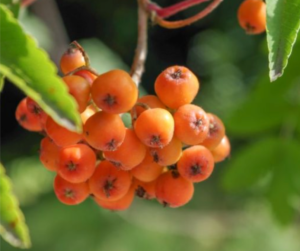
Mountain Ash (Sorbus aucuparia). The name is misleading as it is not actually related to our common Ash, it is only that the leaves are similar in appearance. The ‘Mountain’ part come from its ability to withstand cold, harsh conditions and altitude. It is better known as the Rowan tree. It grows to 6-8m in 10 years and is tolerant of almost all soils and wind. It bears clusters of white flowers in May/June followed by large bundles of orange/red berries in the autum.
The berries are high in vitamin C and were once used to prevent scurvy. Although sour when eaten raw, they are generally made into a jelly as a culinary accompaniment to game, such as deer or pheasant. However, birds are less fussy and will strip and eat a tree of its fruit in next to no time.
The rowan has long been associated with the supernatural. Planted in churchyards to keep the dead in their graves and thus stopping ghosts from disturbing the living, it has also traditionally been used to protect people and livestock from witches and sorcery.
Hazel
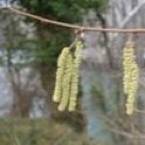
Hazel (Corylus avellana). Common hazel is typically a shrub reaching 3–8 m tall, but can reach 15 m. The leaves are deciduous, rounded, 6–12 cm long and across, softly hairy on both surfaces, and with a double-serrate margin. The flowers are produced very early in spring, before the leaves, and are monoecious with single-sex wind-pollinated catkins. Male catkins are pale yellow and 5–12 cm long, while female catkins are very small and largely concealed in the buds with only the bright red 1–3 mm long styles visible.
The fruit is a nut, produced in clusters of one to five together, each nut held in a short leafy involucre (“husk”) which encloses about three quarters of the nut. The nut is roughly spherical to oval, 15–20 mm long and 12–20 mm broad (larger, up to 25 mm long, in some cultivated selections), yellow-brown with a pale scar at the base. The nut falls out of the involucre when ripe, about 7–8 months after pollination.
Golden Tassels Hops
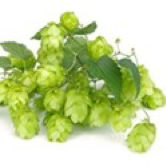
The Orchard bee keeper suggested we plant some hops for the benefit of his bees. Those planting the hops quickly discovered other beneficiaries and expanded the crop to 6 plantings with 3 different varieties.
Golden Tassels (Humulus lupus) hops are one of England’s revolutionay dwarf varieties launched to the trade in September 2003. They are vigorous herbaceous climbers with rough, twining stems, deeply palmately-lobed leaves and small green flowers, male and female on separate plants. The flowers borne on females can be used in dried flower displays or used to make ‘hop pillows’ to aid sleeping. If left, they develop into hops giving a rich citrus character to beers.
Fuggle Hops
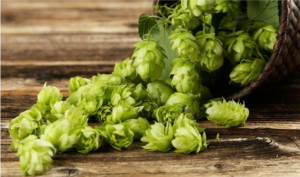
The Orchard bee keeper suggested we plant some hops for the benefit of his bees. Those planting the hops quickly discovered other beneficiaries and expanded the crop to 6 plantings with 3 different varieties.
Fuggle Hops (Humulus lupus) The most revered and famous English hop, known for its full bodied flavor in traditional ales. Discovered as a chance seedling in 1861 and propagated by Richard Fuggle in Kent, England in 1875. Fuggle was once the most prominent English hop and accounted for 78% of production in 1949. It is a low yielding hops variety, one of the lowest. It has moderate disease tolerance and forms medium sized compact bulbs that are ready for harvesting early to mid season.
Fuggle is an aroma hops with a 3.5%-5.5% alpha acid rating. During its peak times over 100 years ago it was used both for bittering as well as aroma in beer. It became less economical as higher alpha varieties came along to use Fuggle for bittering. It carries a high carryophyllene oil as well as farnesene oil content. This combination brings a herbal and woody type of aroma to the finished brew.
Challenger Hops
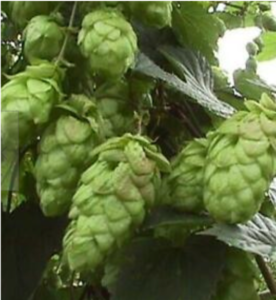
The Orchard bee keeper suggested we plant some hops for the benefit of his bees. Those planting the hops quickly discovered other beneficiaries and expanded the crop to 6 plantings with 3 different varieties.
Challenger Hops (Humulus lupus) Challenger has popularity in beers in England, and was bred at Wye College using Northern Brewer and a German variety in 1961. Challenger was intended to provide high alpha acids, good aroma as well as disease resistance. It has moderate levels of its essential oils. Perhaps this speaks to the balance that it carries in beer. One of the few recognized all-purpose hops combining moderate amounts of alpha acid with a good kettle aroma. Its a low yielding hops variety for harvesting, yet Challenger has good sized cones.
Challenger has great diversity in the beer styles it can be used in. It can be added at the beginning of the boil in brewing for its bitterness or as late additions, and dry hopping for its aroma. The flavor of Challenger in beer is smooth, with floral character and some spice. Some of the sweeter citrus flavors will come through in the beer as well.